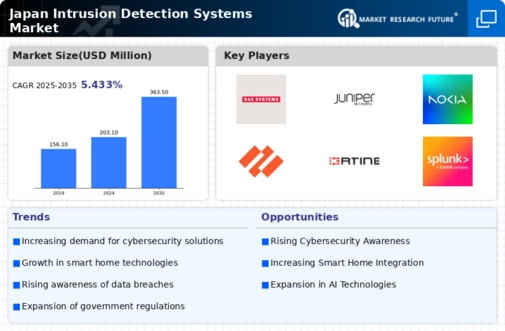Increasing Cyber Threats
The intrusion detection system market is experiencing growth due to the rising frequency and sophistication of cyber threats in Japan. Organizations are increasingly aware of the potential risks posed by cybercriminals, leading to a heightened demand for advanced security solutions. In 2025, it is estimated that cybercrime costs could reach approximately $10 trillion globally, with Japan being a significant contributor to this figure. As businesses and government entities strive to protect sensitive data and maintain operational integrity, investments in intrusion detection systems are likely to surge. This trend indicates a robust market environment, as companies seek to implement proactive measures against potential breaches, thereby driving the intrusion detection-system market forward.
Rising Regulatory Requirements
The intrusion detection-system market is influenced by the increasing regulatory requirements imposed on organizations in Japan. Compliance with data protection laws and industry standards is becoming more stringent, compelling businesses to adopt advanced security measures. The Personal Information Protection Act (PIPA) mandates that organizations implement adequate security measures to protect personal data, which includes the deployment of intrusion detection systems. As regulatory scrutiny intensifies, companies are likely to invest more in security technologies to ensure compliance and avoid potential penalties. This trend indicates a growing market for intrusion detection systems, as organizations strive to meet legal obligations while safeguarding their information assets.
Shift Towards Cloud-Based Solutions
The intrusion detection-system market is witnessing a shift towards cloud-based solutions, driven by the increasing adoption of cloud computing in Japan. Organizations are migrating their operations to the cloud for enhanced flexibility and scalability, which necessitates the implementation of robust security measures. The cloud security market in Japan is expected to grow at a CAGR of around 15% from 2025 to 2030, indicating a strong demand for cloud-based intrusion detection systems. As businesses seek to protect their cloud environments from potential threats, the intrusion detection-system market is likely to expand, reflecting the evolving landscape of cybersecurity in the digital age.
Growing Investment in IT Infrastructure
The intrusion detection-system market is poised for growth as organizations in Japan continue to invest heavily in IT infrastructure. With the digital transformation initiatives gaining momentum, businesses are increasingly recognizing the importance of robust security measures. In 2025, IT spending in Japan is projected to reach approximately $200 billion, with a significant portion allocated to cybersecurity solutions. This investment trend suggests that companies are prioritizing the protection of their digital assets, leading to a greater demand for intrusion detection systems. As organizations enhance their IT frameworks, the intrusion detection-system market is likely to experience substantial growth, driven by the need for comprehensive security solutions.
Technological Advancements in Security Solutions
The intrusion detection-system market is benefiting from rapid technological advancements in security solutions. Innovations such as machine learning and behavioral analytics are enhancing the capabilities of intrusion detection systems, allowing for more accurate threat detection and response. In Japan, the market for cybersecurity solutions is projected to grow at a CAGR of around 12% from 2025 to 2030. This growth is attributed to the increasing adoption of sophisticated technologies that improve the efficiency and effectiveness of security measures. As organizations seek to stay ahead of emerging threats, the demand for cutting-edge intrusion detection systems is expected to rise, further propelling the market's expansion.
























Leave a Comment